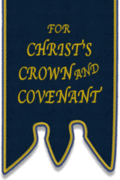Reformed Presbyterian Church of Scotland
| Reformed Presbyterian Church of Scotland | |
|---|---|
 | |
| Classification | Protestant |
| Orientation | Reformed |
| Polity | Presbyterian |
| Origin | 1690 |
| Separations | 1876 Majority joined Free Church of Scotland |
| Congregations | 5 |
| Members | 250 |
The Reformed Presbyterian Church of Scotland is the original church of the Reformed Presbyterian tradition (commonly known as the RP's).[1] The RPCS formed in 1690 when its members declined to be part of the establishment of the Church of Scotland.[2][3] In 1876 the vast majority of Reformed Presbyterians joined the Free Church of Scotland, and thus the present-day RPCS is a continuing church.
History
Reformed Presbyterians have been referred to historically as Covenanters because of their identification with public covenanting in Scotland, beginning in the 16th century. In response to the king's attempts to change the style of worship and form of government in the churches that had previously been agreed upon (covenanted) by the free assemblies and parliament, a number of ministers affirmed their adherence to those previous agreements by becoming signatories to the "National Covenant" of February 1638 at Greyfriars Kirk, in Edinburgh. It is from this that the Blue Banner comes, proclaiming "For Christ's Crown And Covenant", as the Covenanters saw the king's attempt to alter the church as an attempt to claim its headship from Jesus Christ. In August, 1643, the Covenanters signed a political treaty with the English Parliamentarians, called the "Solemn League and Covenant". Under this covenant the signatories agreed to establish Presbyterianism as the national church in England and Ireland. In exchange, the "Covenanters" agreed to support the English Parliamentarians against Charles I of England in the English Civil War. The Solemn League and Covenant asserted the privileges of the "crown rights" of Jesus as king over both Church and state, and the Church's right to freedom from coercive state interference. Oliver Cromwell put the independents in power in England, signalling the end of the reforms promised by the Parliament. When the monarchy was restored in 1660, some Presbyterians were hopeful in the new covenanted king, as Charles II had sworn to the covenants in Scotland in 1650 and 1651. Charles II, however, determined that he would have none of this talk of covenants. While the majority of the population participated in the established church, the Covenanters dissentedstrongly, instead holding illegal worship services in the countryside. They suffered greatly in the persecutions that followed, the worst of which is known as the Killing Times, administered against them during the reigns of Charles II and James VII.
In 1691, Presbyterianism was restored to the established Church in Scotland. Because there was no acknowledgement of the sovereignty of Christ in terms of the Solemn League and Covenant, however, a party of dissenters refused to enter into this national arrangement (the “Revolution Settlement”), on the grounds that it was forced upon the Church and did not adhere to the nation's previous covenanted settlement. These formed into societies which eventually formed the Reformed Presbyterian Church in Scotland. Meanwhile, when persecution broke out after Charles II had declared the Scottish Covenants illegal, tens of thousands of Scottish Covenanters had fled to Ulster, between 1660 and 1690. These Covenanters eventually formed the Reformed Presbyterian Church of Ireland.
After the Revolution Settlement, all of the few remaining Covenanter ministers joined the established church in 1690, leaving the "United Societies" without any ministersfor sixteen years. For those sixteen years the Dissenting Covenanters maintained their Societies for worship and religious correspondence. The Societies numbered about twenty, with a general membership of about seven thousand.
At the end of the sixteen years, Rev. John Macmillan, minister of the parish of Balmaghie, a man of rare force of character and strict integrity, who had tried to persuade his fellow presbyters and churchmen to return to the Covenant ground that they had abandoned, and who had suffered deposition for his persistency, was offered, and accepted, the officer of minister to the Dissenting Societies (1706).
In 1743, another minister, the Rev. Thomas Nairne, who had left the established church and joined the Associate Presbytery, came over to the Societies, which were then constituted the Reformed Presbytery. The church increased in numbers, and in 1810 the Presbytery was divided into three—the Eastern, Northern, and Southern Presbyteries—which met the following year as the first Synod of the Reformed Presbyterian Church of Scotland. In that same year, the Irish and North American Reformed Presbyterian churches, daughters of the Scottish church, were also strong enough for each to constitute its first synod.
Foreign missions
France
The Scottish Church has a direct input into the mission work in Nantes, France via a mission committee which operates under the oversight of the Irish and Scottish RP Churches.
Sudan and Cyprus
The RPCS takes an active interest in these mission works operated under the oversight of the RP Church in North America.
References
- ↑ The literature of the Scottish Reformed Presbyterian Church. Scottish Church History Society. 1935. pp. 227–237. Retrieved 25 August 2018.
- ↑ "The literature of the Scottish Reformed Presbyterian Church, Part II". Scottish Church History Society. 1938: 69–81. Retrieved 25 August 2018.
- ↑ "A Reformed Presbyterian bibliography Part III". Scottish Church History Society: 183–193. 1938. Retrieved 25 August 2018.